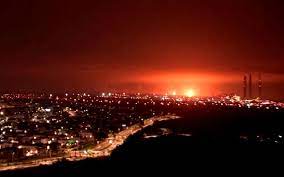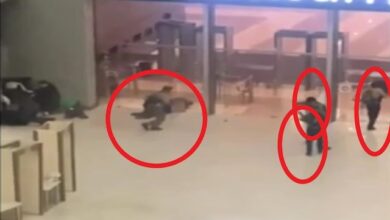The blackout on communications in Gaza ends, raising hopes for the restart of vital aid deliveries
After a telecommunications blackout that prevented the UN from coordinating its convoys and forcing it to halt vital humanitarian relief delivery, internet and phone connectivity were largely restored to the Gaza Strip on Saturday.
Meanwhile, a doctor at the hospital where the victims were carried said that at least 26 Palestinians had been killed in an Israeli airstrike that had struck a residential structure on the outskirts of the town of Khan Younis.
The Israeli military continued to shell Khan Younis and the southern evacuation zone throughout the early stages of the conflict, even though it had ordered residents to leave northern Gaza, which was the focus of its ground operation.
While maintaining operations in the north, including Gaza City, where troops were still looking for signs of a Hamas command center that Israel claims was hidden beneath the building—a claim that both Hamas and the medical staff dispute—Israel has indicated plans to expand its offensive southward.
The incident in Khan Younis happened early on Saturday and targeted Hamad City, a middle-class housing complex that Qatar funded and was constructed recently. Dr. Nehad Taeima of Nasser Hospital said that twenty more individuals were injured in addition to the 26 fatalities.
Israel just states that it is targeting Hamas and attempting to prevent injury to civilians when discussing specific attacks. Women and children have been among the fatalities in several Israeli attacks.
The October 7 assault in southern Israel by Hamas, in which terrorists murdered nearly 1,200 people, largely civilians, and kidnapped around 240 men, women, and children, started the conflict, which is now in its seventh week.
According to Palestinian health officials, more over 11,400 Palestinians have died in the conflict, with women and youngsters making up the majority of the casualties. An other 2,700 people are missing and thought to be buried beneath debris. Israel claims to have killed thousands of terrorists, however the total does not distinguish between fighters and civilians.
The United Nations has issued a warning that food and water supplies are dangerously low for Gaza’s 2.3 million residents. However, it was not immediately apparent when UNRWA, the organization responsible for providing relief to Palestinian refugees, would be able to restart its Friday delivery schedule.
The gasoline donation from UNRWA allowed the Palestinian telecom operator to restart its generators. As service started to resume late Friday night, the communications blockade ended, allowing users to once again access news and messages from journalists and activists within the beleaguered enclave on social media sites.
AID DETECTS
Israel has cut off Gaza’s electrical supplies since the major power plant in Gaza closed early in the conflict. This means that fuel is required to operate the generators that run the water treatment plants, hospitals, sanitary facilities, and other vital infrastructure in addition to the telecommunications network.
Since the beginning of the conflict, Israel has prohibited the entrance of gasoline, claiming that Hamas would use it for military purposes. Aside from a sliver of relief from Egypt that humanitarian workers claim is far short of what is required, it has also stopped the flow of food, water, and other supplies.
According to the U.S. State Department, Israel said that it would accept 10,000 liters (2,641 gallons) of gasoline each day going ahead in order to maintain communications service. Furthermore, according to Israeli National Security Advisor Tzachi Hanegbi, Israel consented on Friday to the US proposal to let a “very minimal” quantity of petroleum into Gaza each day for humanitarian reasons. COGAT, the Israeli military agency in charge of Palestinian affairs, estimated that the daily quantity for the United Nations would be 60,000 liters (15,850 gallons).
However, according to the U.N., that only accounts for 37% of the gasoline required by UNRWA to conduct its humanitarian activities, which include food distribution and the running of generators at hospitals and facilities for water and sanitation.
The U.N. reports that just 10% of Gaza’s daily food needs are being met by imports from Egypt; also, the water system outage has left the majority of the population drinking tainted water, leading to a disease epidemic.
Nearly all of the population is in need of food, and dehydration and malnutrition are on the rise, according to the United Nations World Food Program.
A MONTH OF HOSTAGES
Before, Israeli authorities had promised that gasoline would not be let in until the captives were released by Gaza militants. The public has put significant pressure on the administration to demonstrate that it is making every effort to rescue those kidnapped in the Hamas raid.
With the slogan “Bring them home!” thousands of protestors, including the relatives of more than fifty captives, set off on Friday on the fourth day of their five-day journey from Tel Aviv to Jerusalem. They were calling on Benjamin Netanyahu’s war cabinet to do more to save their loved ones, and they were marching to his office. They have pushed the Cabinet to think about exchanging prisoners or a cease-fire for the hostages.
The Cabinet turned down Hamas’ offer to swap all the hostages for over 6,000 Palestinian prisoners held in Israeli prisons.
SUMMARY ABOUT SHIFA
Doctors described appalling circumstances inside the Shifa Hospital complex, while Israeli forces were stationed surrounding it. Since there hasn’t been electricity for over a week, ventilators for ICU patients and incubators for babies are no longer functional. There are over 7,000 people stuck there, including workers, patients, and civilian families, with insufficient food.
According to Mohammed Abu Selmia, the director of the hospital, Israeli forces should either provide fuel to run the equipment or permit an evacuation, as reported by Al Jazeera television.
He said, “The hospital has turned into a massive prison.” “Death is all around us.”
Although the Israeli military claimed to have sent 1,500 pre-made meals and 4,000 liters (1,056 gallons) of water to Shifa, personnel said the supplies were insufficient for the large number of residents.
Col. Richard Hecht, spokesman for the Israeli military, said that the forces’ hunt for Hamas remnants was progressing slowly. “It will require some time,” he said.
Pressure is on Israel to substantiate its allegation that Hamas established its primary command center inside and under the hospital. Israel has so far released images and video purporting to reveal weapons stores and what it claims to be a tunnel entrance. The Israeli assertions could not be independently verified by the AP.
These claims are a part of Israel’s larger charge that Hamas utilizes Palestinians as human shields across the Gaza Strip, which it claims is the cause of the significant civilian fatalities that have occurred during weeks of shelling.
GOING NORTHWEST
As part of its commitment to overthrow Hamas and destroy its military capabilities, Israel has concentrated its ground offensive so far on the northern part of Gaza. It is unclear where the Palestinians can go if the attack spreads south. Egypt has objected to a mass transfer taking place on its territory.
The majority of Palestinians living in the area, including hundreds of thousands of civilians who followed Israel’s orders to flee Gaza City and the north in order to avoid its ground onslaught, are now taking refuge in the south.
Staff at a local hospital said that 41 more people were murdered on Friday in an assault that struck the Nuseirat Refugee Camp, resulting in the collapse of a structure, in addition to the strikes that occurred on Friday and Saturday in the Khan Younis region.







